|
|
Title | Date | Type |
| 51 |
 |
Distal half of femur, Allosaurus, faulted. | 1950; 1951; 1952; 1953; 1954; 1955; 1956; 1957; 1958; 1959; 1960; 1961; 1962; 1963; 1964; 1965; 1966; 1967; 1968; 1969; 1970; 1971; 1972; 1973; 1974; 1975; 1976; 1977; 1978; 1979; 1980; 1981; 1982; 1983; 1984; 1985; 1986; 1987; 1988; 1989; 1990; 1991; 1992; 1993; 1994; 1995; 1996; 1997; 1998; 1999 | Image |
| 52 |
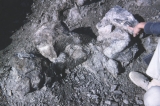 |
Dorsal plate and caudal (?) vertebrae, Camarasaurus (UUVP 2292, 2293). | 1950; 1951; 1952; 1953; 1954; 1955; 1956; 1957; 1958; 1959; 1960; 1961; 1962; 1963; 1964; 1965; 1966; 1967; 1968; 1969; 1970; 1971; 1972; 1973; 1974; 1975; 1976; 1977; 1978; 1979; 1980; 1981; 1982; 1983; 1984; 1985; 1986; 1987; 1988; 1989; 1990; 1991; 1992; 1993; 1994; 1995; 1996; 1997; 1998; 1999 | Image |
| 53 |
 |
Dorsal rib, sauropod. | 1950; 1951; 1952; 1953; 1954; 1955; 1956; 1957; 1958; 1959; 1960; 1961; 1962; 1963; 1964; 1965; 1966; 1967; 1968; 1969; 1970; 1971; 1972; 1973; 1974; 1975; 1976; 1977; 1978; 1979; 1980; 1981; 1982; 1983; 1984; 1985; 1986; 1987; 1988; 1989; 1990; 1991; 1992; 1993; 1994; 1995; 1996; 1997; 1998; 1999 | Image |
| 54 |
 |
Dorsal vertebra, Camarasaurus (UUVP 0785). | 1950; 1951; 1952; 1953; 1954; 1955; 1956; 1957; 1958; 1959; 1960; 1961; 1962; 1963; 1964; 1965; 1966; 1967; 1968; 1969; 1970; 1971; 1972; 1973; 1974; 1975; 1976; 1977; 1978; 1979; 1980; 1981; 1982; 1983; 1984; 1985; 1986; 1987; 1988; 1989; 1990; 1991; 1992; 1993; 1994; 1995; 1996; 1997; 1998; 1999 | Image |
| 55 |
 |
Duane Stone (U of U, Geology student). | 1960; 1961; 1962; 1963; 1964; 1965; 1966; 1967; 1968; 1969; 1970; 1971; 1972; 1973; 1974; 1975; 1976; 1977; 1978; 1979 | Image |
| 56 |
 |
Duane Stone (U of U, Geology student). | 1960; 1961; 1962; 1963; 1964; 1965; 1966; 1967; 1968; 1969; 1970; 1971; 1972; 1973; 1974; 1975; 1976; 1977; 1978; 1979 | Image |
| 57 |
 |
During the 1960s at Fort Douglas, east of Salt Lake City, Utah was a World War II, army barracks, no longer standing on the upper University of Utah Campus, known as the "Bone Barn". It was the first "home" of the extensive bone inventory collected from the Cleveland-Lloyd Dinosaur Quarry. More than 60% of the original collection remained in Utah after the commitments to supporting institutions were met. These institutions had provided financial support for excavation, preparation, and research to the University of Utah Cooperative Dinosaur Project from 1960 to 1968. (June 1968) | 1968-06 | Image |
| 58 |
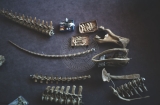 |
The entire mount is prepared in segments and modules that facilitate easy transportation, handling, and assembly. | 1968-10 | Image |
| 59 |
 |
Femur?, unidentified taxon. | 1950; 1951; 1952; 1953; 1954; 1955; 1956; 1957; 1958; 1959; 1960; 1961; 1962; 1963; 1964; 1965; 1966; 1967; 1968; 1969; 1970; 1971; 1972; 1973; 1974; 1975; 1976; 1977; 1978; 1979; 1980; 1981; 1982; 1983; 1984; 1985; 1986; 1987; 1988; 1989; 1990; 1991; 1992; 1993; 1994; 1995; 1996; 1997; 1998; 1999 | Image |
| 60 |
 |
Foothill Junior College students, circa 1976. | 1960; 1961; 1962; 1963; 1964; 1965; 1966; 1967; 1968; 1969; 1970; 1971; 1972; 1973; 1974; 1975; 1976; 1977; 1978; 1979 | Image |
| 61 |
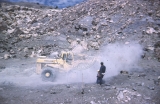 |
For nearly 20 years following the initial Quarry opening by the University of Utah Cooperative Dinosaur Project in 1960, it was necessary to open and close the Quarry with heavy equipment each field season to protect it from vandalism and illegal collecting. (October 1961) | 1961-10 | Image |
| 62 |
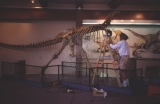 |
The forearms are pinned in place after the dorsal ribs have been attached. | 1968-10 | Image |
| 63 |
 |
The fossiliferous unit at the C-LDQ, which consists of poorly stratified to blocky, bentonitic shales, is overlain by a dense, hard, siliceous, freshwater limestone. The surface between the two units shows evidence of channeling as seen here. (June 1961) | 1961-06 | Image |
| 64 |
 |
Fragments of a right ilium, Allosaurus. | 1950; 1951; 1952; 1953; 1954; 1955; 1956; 1957; 1958; 1959; 1960; 1961; 1962; 1963; 1964; 1965; 1966; 1967; 1968; 1969; 1970; 1971; 1972; 1973; 1974; 1975; 1976; 1977; 1978; 1979; 1980; 1981; 1982; 1983; 1984; 1985; 1986; 1987; 1988; 1989; 1990; 1991; 1992; 1993; 1994; 1995; 1996; 1997; 1998; 1999 | Image |
| 65 |
 |
Full scale replicas of two Allosaurus sculpted by David Thomas, a well- known dinosaur artist who worked in Albuquerque, New Mexico. | 1960; 1961; 1962; 1963; 1964; 1965; 1966; 1967; 1968; 1969; 1970; 1971; 1972; 1973; 1974; 1975; 1976; 1977; 1978; 1979 | Image |
| 66 |
 |
The fused caudal vertebrae and a chevron of Allosaurus show extensive pathology involving the transverse process of the right side. Traumas to the tails of dinosaurs are among the more common pathologies. | 1960; 1961; 1962; 1963; 1964; 1965; 1966; 1967; 1968; 1969; 1970; 1971; 1972; 1973; 1974; 1975; 1976; 1977; 1978; 1979 | Image |
| 67 |
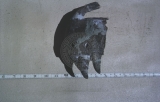 |
Fused premaxillae of Ceratosaurus, left lateral view. | 1960; 1961; 1962; 1963; 1964; 1965; 1966; 1967; 1968; 1969; 1970; 1971; 1972; 1973; 1974; 1975; 1976; 1977; 1978; 1979 | Image |
| 68 |
 |
Here is a scientific illustration of the skull of Camarasaurs lentus. Superior illustrations often are the most important part of a paper presenting a scientific description of a fossil bone, because they allow interpretation, not always possible, even with the best photographs. (March 1994) | 1994-03 | Image |
| 69 |
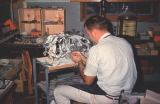 |
Here is the backlighted braincase of Camarasaurus, which was projected at 2/3 natural size on a sheet of drawing paper. Next, a sketch would be made noting the complete outline and all features. This sketch would be used by the artist, as a basis for the illustration needed for a scientific publication. The sketch would be reduced 50% for a printed size of 1/3 scale. (May 1984) | 1984-05 | Image |
| 70 |
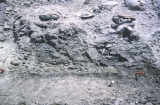 |
Horizon showing soft, bentonitic shale unit underlying more massive unit. | 1950; 1951; 1952; 1953; 1954; 1955; 1956; 1957; 1958; 1959; 1960; 1961; 1962; 1963; 1964; 1965; 1966; 1967; 1968; 1969; 1970; 1971; 1972; 1973; 1974; 1975; 1976; 1977; 1978; 1979; 1980; 1981; 1982; 1983; 1984; 1985; 1986; 1987; 1988; 1989; 1990; 1991; 1992; 1993; 1994; 1995; 1996; 1997; 1998; 1999 | Image |
| 71 |
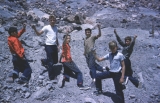 |
If the young prospectors were lucky and raised their hands when asked about their success, we would have them "donate" their significant finds to the collection. They were allowed to keep fragments of no scientific value. (June 1961) | 1961-06 | Image |
| 72 |
 |
In numerical order, each fossil is cataloged, measured, identified, and carefully plotted on a base map before it is removed from the Quarry surface. This is just one part of the precise record keeping at the Quarry and compilation of the important data on the thousands of individual fossils exposed and collected there. (July 1961) | 1961-06 | Image |
| 73 |
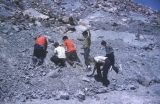 |
In the early years, young visitors to the C-LDQ were allowed to dig in the spoil piles next to the excavation. (June 1961) | 1961-06 | Image |
| 74 |
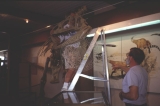 |
Installation of the skull is a two person job. | 1968-10 | Image |
| 75 |
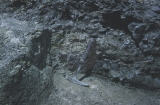 |
Interesting shots of flat-lying, blockey shale near the base of the fossiliferous unit. | 1950; 1951; 1952; 1953; 1954; 1955; 1956; 1957; 1958; 1959; 1960; 1961; 1962; 1963; 1964; 1965; 1966; 1967; 1968; 1969; 1970; 1971; 1972; 1973; 1974; 1975; 1976; 1977; 1978; 1979; 1980; 1981; 1982; 1983; 1984; 1985; 1986; 1987; 1988; 1989; 1990; 1991; 1992; 1993; 1994; 1995; 1996; 1997; 1998; 1999 | Image |